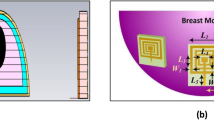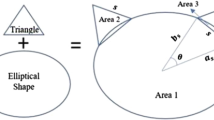Abstract
A novel design methodology for an improved hairpinline microstrip narrowband bandpass filter is presented in this paper. The new proposed methodology incorporates use of via ground holes and a capacitive gap to improve the performance and dimensions of a conventional hairpinline bandpass filter. This design approach incorporates use of \(\lambda \)/4 resonators thus reducing the overall size of the filter by 15.5 % as compared to the conventional design. A capacitive gap is also introduced in the center of the center resonator. The proposed design achieves 3 dB fractional bandwidth less than 4 %, insertion loss less than 0.8 dB and return loss better than 40 dB at the center frequency of 1 GHz. The effects of tap point height, characteristic impedance and gap width are analyzed in detail and subsequent relationships are developed with the fundamental design parameters. Based on the proposed design, a bandpass filter is designed and fabricated on FR4 substrate, and good agreement is observed between measured and simulated results.

















Similar content being viewed by others
References
Hong, J.-S., & Lancaster, M. J. (2001). Lowpass and bandpass filters (pp. 109–159). New York: Wiley.
Wong, J. S. (1979). Microstrip tapped-line filter design. IEEE Transactions on Microwave Theory and Techniques, 27(1), 44–50.
Hong, J.-S., & Lancaster, M. J. (1988). Cross-coupled microstrip hairpin-resonator filters. IEEE Transactions on Microwave Theory and Techniques, 46(1), 118–122.
Gu, Q. (2005). RF system design of transceivers for wireless communications. New York: Springer.
Henkes, Dale D. (2003). Designing short high Q resonators. Microwaves and RF, 42, 75.
Stephen, W. S., & Levien, F. H. (1985). Microwave made simple: Principles and applications. Dedham: Artech House.
Hasan, A., & Nadeem, A. E. (2008). Novel microstrip hairpinline narrowband bandpass filter using via ground holes. Progress in Electromagnetics Research, 78, 393–419.
Swanson, D. G. (1992). Grounding microstrip lines with via holes. IEEE Transactions on Microwave Theory and Techniques, 40(8), 1719–1721.
Kikuchi, K., Pak, J. S., Aoyagi, M., & Joungho, K. (2006). and-stop filter effect of power/ground plane on through-hole signal via in multilayer PCB. IEICE Transactions on Electronics, E89(C(4)), 551–559.
Pozar, D. M. (1998). Microwave engineering (2nd ed.). New York: Wliey.
Author information
Authors and Affiliations
Corresponding author
Rights and permissions
About this article
Cite this article
Hasan, A., Hannan, A. & Nadeem, A.E. Improved microstrip hairpinline bandpass filter using via ground holes and capacitive gap. Analog Integr Circ Sig Process 86, 267–274 (2016). https://doi.org/10.1007/s10470-015-0674-0
Received:
Accepted:
Published:
Issue Date:
DOI: https://doi.org/10.1007/s10470-015-0674-0




